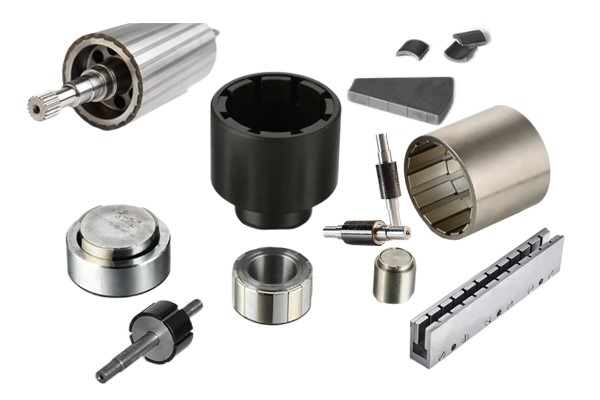Magnetic paint, also known as magnetic primer or magnetic receptive paint, is a type of paint that contains ferrous particles or other magnetic materials, allowing it to attract magnets. When applied to a surface, such as a wall or furniture, magnetic paint turns that surface into a receptive area where magnets can stick and hold. This characteristic makes it possible to create interactive and functional spaces by using magnets to attach various items directly to the painted surface.

Here are some key points about magnetic paint:
Composition: Magnetic paint is typically a primer that contains ferrous particles, iron oxides, or other magnetic materials. These particles provide the magnetic properties that allow the painted surface to attract and hold magnets.
Application: Magnetic paint is applied like regular paint. It usually requires multiple coats for optimal magnetic strength. After applying the magnetic paint, additional coats of regular paint or decorative finishes can be added to achieve the desired appearance.
Versatility: One of the main advantages of magnetic paint is its versatility. It can be applied to various surfaces, including walls, furniture, doors, or other flat surfaces. This versatility allows for creative and functional applications in different areas of the home or office.
Functionality: Once the magnetic paint has dried and cured, the painted surface becomes magnetically receptive. This means that magnets can be used to attach and display items such as artwork, photos, notes, or any other magnetic objects. Magnetic paint adds an interactive and dynamic element to spaces, allowing for easy customization and changes.
DIY-Friendly: Magnetic paint is often marketed as a do-it-yourself (DIY) product, making it accessible to homeowners who want to add a unique feature to their living spaces without major renovations. However, it's essential to follow the manufacturer's instructions for application to ensure optimal performance.
Applications: Magnetic paint has a range of applications, from functional uses such as creating magnetic walls for notes and artwork to more decorative uses like displaying magnetic artwork or interactive displays in commercial spaces.
Magnets themselves cannot be painted in the traditional sense, as they are typically made of materials like metal or alloys that are not conducive to standard paint adhesion. However, there are alternative ways to incorporate the appearance of paint onto magnets or create a painted effect in combination with magnets:
- Magnetic Paint: As discussed earlier, you can paint surfaces with magnetic paint to make them magnetically receptive. This allows you to use magnets on the painted surface. However, this doesn't involve painting the magnets themselves.
- Decorating Magnets: If you have plain or unadorned magnets, you can decorate them by attaching various materials to the magnet's surface. For example, you could glue small decorative items or adhere paper with designs onto the magnet. This gives the appearance of the magnet being decorated, but the decoration is on the surface, not a painted layer.
- Customizing Magnet Surfaces: While you can't paint the magnets themselves, you can customize the surfaces to which magnets adhere. For example, you can paint a magnetic board or other surfaces where magnets are used to create a visually appealing background. The magnets, in this case, remain unchanged, but the overall display is enhanced.
- Adhesive Stickers or Decals: You can also use adhesive stickers or decals on the surface of magnets to create a painted or decorated look. These can add color, patterns, or images to the magnets without altering the magnet's material.
Does magnetic paint work?
Yes, magnetic paint does work, but it's important to understand its capabilities and limitations. Magnetic paint contains ferrous particles or other magnetic materials that give the painted surface the ability to attract and hold magnets. When properly applied and cured, the painted area becomes magnetically receptive, allowing you to use magnets to attach various items directly to the surface.
Here are some key considerations regarding the effectiveness of magnetic paint:
- Strength of Magnetic Field: The strength of the magnetic field produced by magnetic paint may not be as powerful as traditional magnets on metal surfaces. The holding capacity is typically suitable for lightweight items such as paper, photos, or lightweight decorations. It may not be as strong as dedicated magnetic boards or metal surfaces.
- Application and Thickness: Proper application and multiple coats are crucial for achieving the desired magnetic strength. Following the manufacturer's instructions for application is essential to ensure optimal performance. Applying additional coats of magnetic paint can enhance its magnetic properties.
- Surface Type: Magnetic paint is most effective on flat surfaces. The smoother the surface, the better the magnetic properties. It may not work as well on textured surfaces, and the effectiveness can vary based on the type of surface being painted.
- Decorative Finishes: After applying magnetic paint, additional coats of regular paint or decorative finishes can be added. The final appearance and texture of the surface depend on these additional layers.
- Versatility: Magnetic paint is versatile and can be applied to various surfaces, including walls, furniture, doors, and more. Its versatility allows for creative and functional applications in different areas of the home or office.
- DIY-Friendly: Many magnetic paint products are marketed as DIY-friendly, making them accessible to homeowners who want to add a unique feature to their spaces without significant renovations.
Conclusions
Magnetic paint proves effective in certain scenarios. Opting for an actual sheet of steel or a magnetic whiteboard provides a more robust magnetic hold compared to relying solely on magnetic paint. For enhanced performance when using magnetic paint, consider applying double the recommended number of coats. Exercise caution and refrain from introducing a
powerful magnet into wet paint, as this can lead to an intriguing yet potentially messy outcome!















